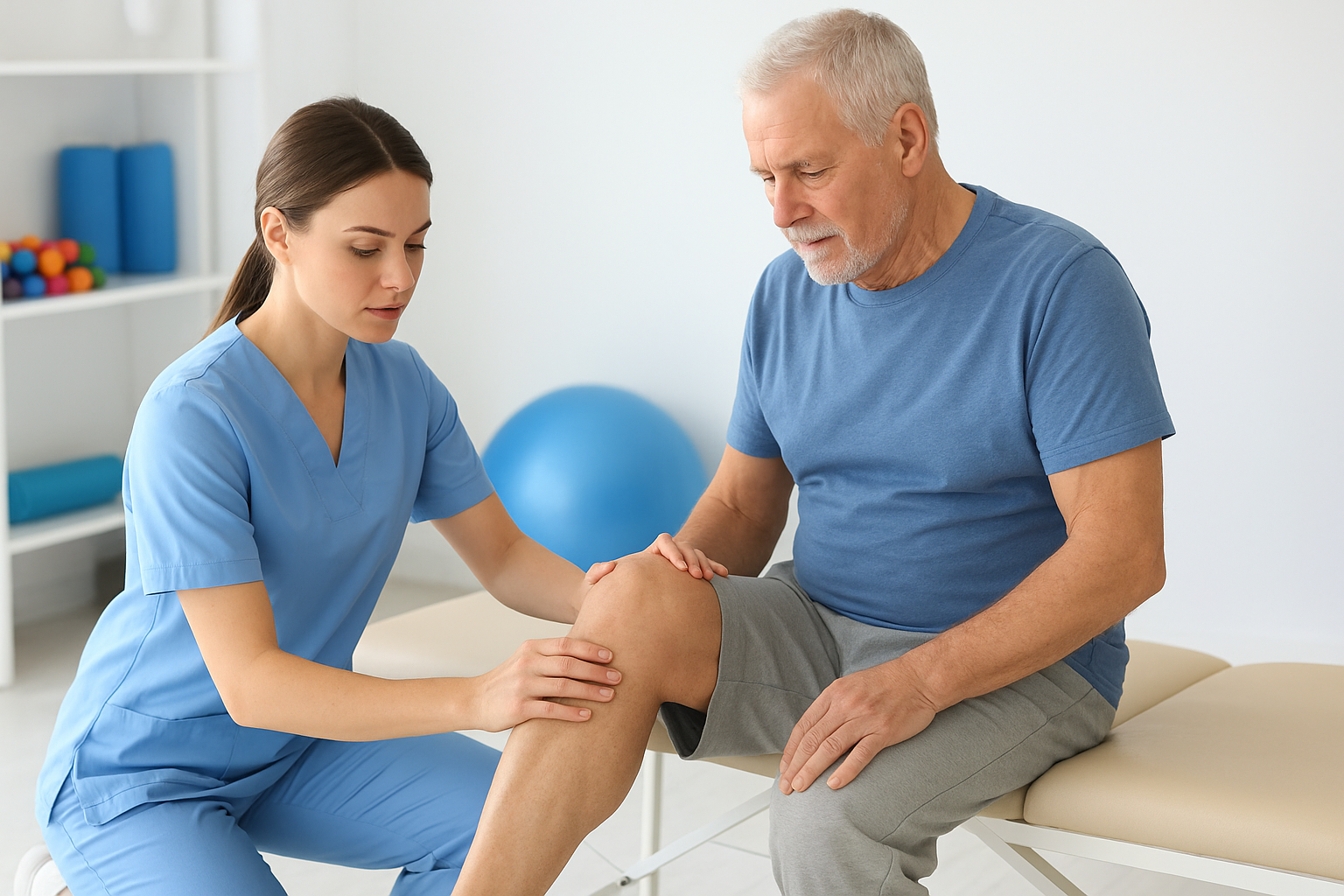Introduction: Managing Arthritis the Smarter Way
Arthritis — a condition that causes inflammation and stiffness in the joints — affects millions worldwide. Whether it’s osteoarthritis or rheumatoid arthritis, chronic joint pain can limit movement and affect daily life.
While painkillers offer temporary relief, physiotherapy provides a long-term, natural approach to managing arthritis pain. Through joint mobilization, strengthening, and posture correction, physiotherapy not only reduces discomfort but also improves flexibility and muscle support around the joints.
According to the Arthritis Foundation (2024), regular physiotherapy can reduce joint pain by 40–60% and enhance range of motion significantly when done consistently.
This guide walks you through how to use physiotherapy for arthritis pain relief — from warm-ups to targeted exercises, lifestyle tips, and recovery routines.
Understanding Arthritis and Why Physiotherapy Helps
Arthritis causes joint inflammation, leading to pain, swelling, and stiffness. Over time, it weakens surrounding muscles and reduces flexibility.
Physiotherapy plays a vital role in retraining the body’s movement patterns and reducing pressure on inflamed joints.
How physiotherapy helps:
- Improves joint mobility and muscle strength
- Enhances blood circulation to reduce inflammation
- Encourages natural lubrication of joints through movement
- Prevents joint deformity and stiffness
- Reduces reliance on pain medication
👉 Tip: Early physiotherapy intervention can delay arthritis progression and prevent permanent joint damage.
Step-by-Step Guide: How to Use Physiotherapy for Arthritis Pain
Step 1: Assessment and Goal Setting
A physiotherapist will assess:
- Type and stage of arthritis
- Range of motion and pain level
- Gait and posture issues
Based on this, a personalized therapy plan is created — balancing strengthening, flexibility, and endurance exercises.
Step 2: Start with Gentle Warm-Up Exercises
Begin each session with low-impact warm-ups to loosen stiff joints and prepare muscles.
Examples:
- Arm circles and shoulder rolls
- Gentle neck stretches
- Walking in place for 3–5 minutes
These simple movements help reduce stiffness and prevent injury during advanced exercises.
Step 3: Strengthening the Supporting Muscles
Strong muscles protect weak joints by reducing load and friction.
For Knee Arthritis:
- Quadriceps strengthening — straight leg raises
- Hamstring curls — standing or prone positions
For Shoulder or Wrist Arthritis:
- Resistance band pulls
- Isometric contractions (holding position without joint movement)
For Hip Arthritis:
- Glute bridges
- Side leg lifts
Perform 10–12 repetitions of each, 3–4 times a week.
Step 4: Improve Flexibility and Range of Motion
Gentle stretching restores joint flexibility and reduces stiffness.
Try these flexibility exercises:
- Cat-Cow pose (spine mobility)
- Ankle circles (ankle arthritis)
- Finger stretches (hand arthritis)
- Pendulum swings (shoulder relaxation)
Each stretch should be slow and controlled, never forced.
Step 5: Include Hydrotherapy and Heat Therapy
Physiotherapists often use hydrotherapy (water exercises) for arthritis, as water supports body weight and reduces joint strain.
Heat therapy (like hot packs or paraffin wax baths) improves blood flow, easing stiffness.
Alternatively, cold therapy can soothe inflammation after exercise.
Step 6: Posture Correction and Balance Training
Arthritis often alters posture, especially in the spine, knees, and hips. Physiotherapists teach ergonomic posture techniques to prevent added stress.
Examples:
- Standing tall with even weight on both feet
- Avoiding slouching when sitting
- Using cushions for lumbar support
Balance exercises:
- Heel-to-toe walking
- Standing on one foot (with support)
These prevent falls and maintain stability, especially in older adults.
Physiotherapy Tools and Modalities Used
Modern physiotherapy for arthritis uses a combination of manual therapy and electrotherapy techniques:
| Technique | Benefit |
| Ultrasound therapy | Deep heating to ease joint stiffness |
| TENS (Transcutaneous Electrical Nerve Stimulation) | Reduces pain by blocking nerve signals |
| Manual therapy | Restores movement through gentle joint manipulation |
| Laser therapy | Promotes tissue healing and reduces inflammation |
| Kinesio taping | Provides joint support and pain relief during movement |
These methods complement exercise-based therapy for better outcomes.
Daily Physiotherapy Routine for Arthritis Relief
| Time | Activity | Duration |
| Morning | Warm-up stretches | 5–10 mins |
| Midday | Strength exercises | 15 mins |
| Evening | Gentle yoga or walking | 20 mins |
| Night | Heat therapy & relaxation | 10 mins |
Consistency is key — even 20 minutes a day can bring visible improvement in flexibility and pain levels within 4 weeks.
Lifestyle and Home Care Tips
Combine physiotherapy with these self-care habits for lasting relief:
- Maintain healthy weight — reduces pressure on knees and hips.
- Eat anti-inflammatory foods — turmeric, omega-3 fish, flaxseeds.
- Stay active but balanced — avoid overexertion.
- Use assistive devices like walking sticks if needed.
- Follow ergonomic practices at work and home.
When to See a Physiotherapist
Visit a physiotherapist if you experience:
- Increased joint stiffness after inactivity
- Pain interfering with daily activities
- Muscle weakness around joints
- Recurrent swelling despite medication
Early therapy ensures better long-term results and reduces complications.
Conclusion: Move Freely, Live Comfortably
Physiotherapy isn’t just about treating arthritis pain — it’s about restoring movement and independence. With regular guided sessions, strengthening exercises, and lifestyle discipline, people with arthritis can live active, pain-free lives.
Remember: the key lies in consistency, correct technique, and patience. With time, physiotherapy can transform your joint health — helping you walk, bend, and move with confidence again.
FAQs
1. Can physiotherapy cure arthritis permanently?
No, arthritis cannot be completely cured, but physiotherapy significantly reduces pain and prevents further joint damage.
2. How often should I do physiotherapy exercises?
Ideally 4–5 days a week under expert supervision, then continue home exercises regularly.
3. Is physiotherapy safe for elderly arthritis patients?
Yes, when customized properly. Physiotherapists adjust intensity and use gentle movements for seniors.
4. What is the best time to exercise for arthritis?
Mornings are ideal since stiffness is highest then. Gentle exercises improve blood flow for the rest of the day.
5. Can I combine physiotherapy with Ayurvedic treatments?
Yes, combining physiotherapy with natural anti-inflammatory remedies (like turmeric or oil massage) enhances relief.

